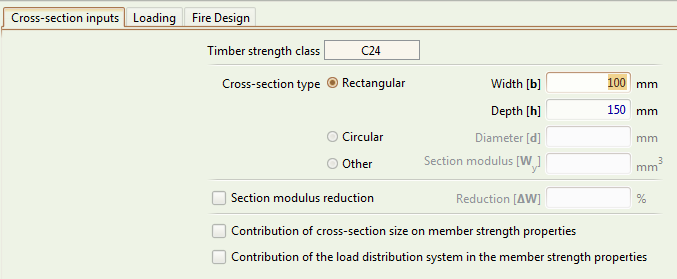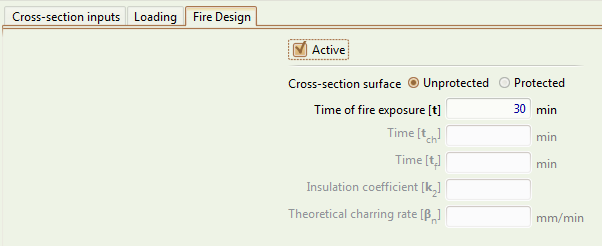Bending
Checks a cross-section in bending about a single axis according to Clause 6.1.6.
All references to EN 1995-1-1:2004+A2:2014 unless otherwise stated.
Cross-section Inputs tab

Timber class
The timber strength class of the cross-section. See the timber database page for the types supported by Teretron.
Cross-section type
The geometry type of the cross-section.
Width
The width of a rectangular cross-section, in mm.
Depth
The depth of a rectangular cross-section, in mm.
Diameter
The diameter of a circular cross-section, in mm.
Section modulus
The section modulus about the y-y axis of a generic cross-section, in .
Section modulus reduction
The section modulus reduction ΔW refers to reductions in the nominal cross-section size that have to be taken into account in the calculation of the member strength (e.g. holes from fasteners) according to Subclause 5.2(2).
It should be given as a percentage of the total nominal section modulus of the cross-section.
Contribution of cross-section size on the determination of member strength properties
Includes factors (or for LVL) for the calculation of the member strength in solid timber, glulam and LVL, according to Clauses 3.2, 3.3, and 3.4.
Contribution of the load distribution system in the member strength properties
Includes factor for the calculation of the member strength, according to Clause 6.6, for a member that functions as part of a continuous load distribution system.
Note that Subclause 6.6(3) states that the strength verification for a continuous load distribution system should be carried out assuming short-term load duration.
Loading Inputs tab

Design moment
The design value of the bending moment about the y-y axis, in kNm.
Load duration class
The Load Duration Class, as defined in Clause 2.3.1.2.
Service class
The Service Class, taking into account the temperature and relative humidity of the environment, as described in Clause 2.3.1.3.
Factor taking into account the effect of the duration of the loads and the moisture content, according to Clause 3.1.3.
Fire Design tab

Active
Selects if this cross-section will also be designed against fire.
Cross-section surface
Defines if the cross-section surface is unprotected (exposed to fire on all sides) or is protected (on all sides).
Time of fire exposure t
The time of the exposure of the cross-section to fire, in minutes.
Time
The time of exposure of a protected cross-section to fire until it starts to char, in minutes.
Time
The time of exposure of a protected cross-section to fire until the protection fails completely, in minutes.
Note that this is can be longer (but not shorter) than .
Factor
Factor defines the charring rate of a protected cross-section between the time it starts to char and the time the protection fails completely.
It is required when has a different value to .
Theoretical charring rate
The theoretical charring rate of the timber, in mm per minute.
It is required for plywood where the relevant standards do not provide a default value